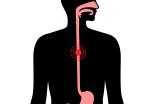We're hiring ! Join us and make a difference in our hospitals
Respiratory complications of oesophageal atresia

What is it?
Oesophageal atresia is a congenital malformation (thus from birth) of the oesophagus whereby the upper and lower sections are disconnected, preventing food from passing to the stomach.
It is the result of a poor separation during the first weeks of pregnancy of the oesophagus and the trachea that transports air to the lungs. Abnormal connections (known as fistulas) between the oesophagus and the trachea are also often found. Treatment of oesophageal atresia must always be surgical. Other malformations can also be present (VACTERL Syndrome).Oesophageal atresia therefore requires a multidisciplinary approach at an expert centre.
Care
At the Children’s Hospital, children who have undergone surgery for oesophageal atresia are followed up by a consultation by a multidisciplinary team that includes a gastroenterologist, a digestive surgeon and a pulmonologist who work closely together with other specialists such as the cardiologist, orthopaedic surgeon and speech therapist so as to rapidly detect any associated complications that can then be treated and if possible avoided. This has the benefit of enabling parents to consult simultaneously the three specialists who examine each child and to draw up together a specific, adapted treatment plan. A report on this consultation is sent systematically to the paediatrician and/or GP.
In addition to digestive complications such as gastroesophageal reflux, children with oesophageal atresia have a “soft” trachea (known as tracheomalacia) that impedes the transport of secretions (mucous) through the trachea. This results in local accumulations that can lead to infections. A number of other factors can also render these children more fragile at the respiratory level, such as gastroesophageal reflux, viruses, allergies and asthma. There can also be a recurrence of the fistula between the oesophagus and the trachea, causing a cough or respiratory infections. The diagnosis must be rapid and treatment initiated without delay.
Advice for parents
If your child has been operated on for an oesophageal atresia, at the respiratory level you should be aware of the following:
- There is a risk of more frequent coughing to evacuate secretions, of passages being more often blocked and of asthma-like symptoms.
- Respiratory infections can more frequently result in complications such as bronchiolitis or pneumonia that require respiratory physiotherapy or antibiotics. Hospitalisation may also be necessary. So please do not hesitate to contact your team pulmonologist!
- It is important to administer medicines (antacids) in accordance with the doctor’s recommendations.
- Do not hesitate to contact the website of the Belgian Association of Families affected by Oesophageal Atresia


Focus
At the Children’s Hospital a less invasive technique is practiced in the event of fistula recurrence in patients who have already been operated on for oesophageal atresia so as to avoid further surgery.
The diagnosis is made possible by a bronchoscopy to visualise the respiratory tract and the connection between the oesophagus and the trachea by administering methylene blue into the oesophagus (methylene blue test). The fistula is also closed by means of a bronchoscopy rather than by surgery by applying cotton wool soaked in an acid solution (chemocauterisation).
Our specialists
